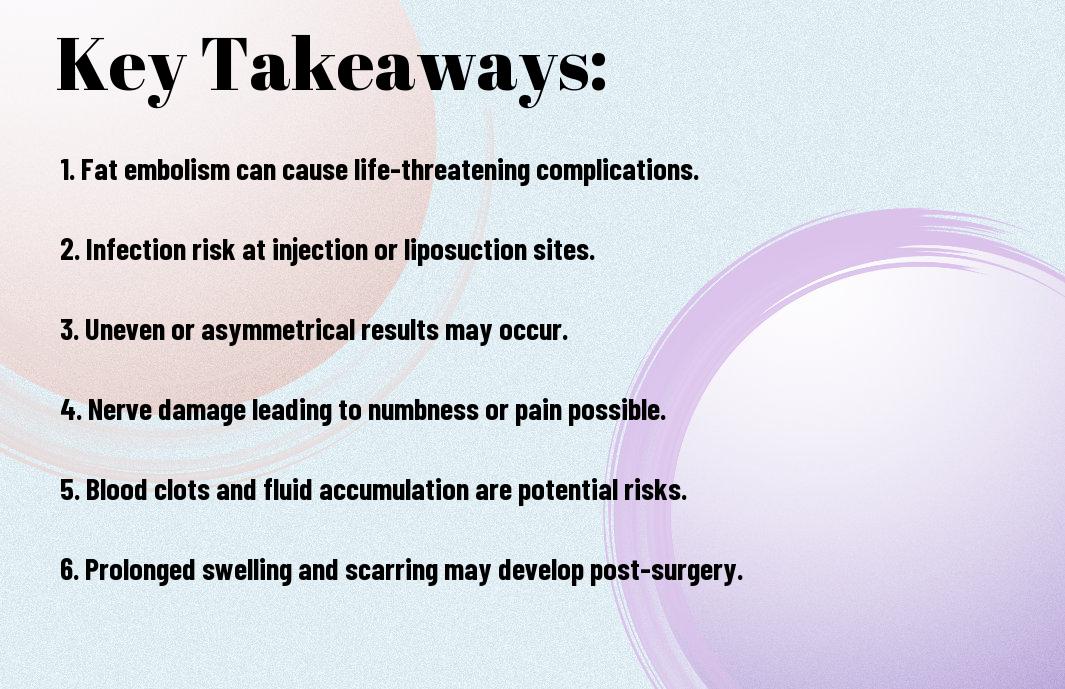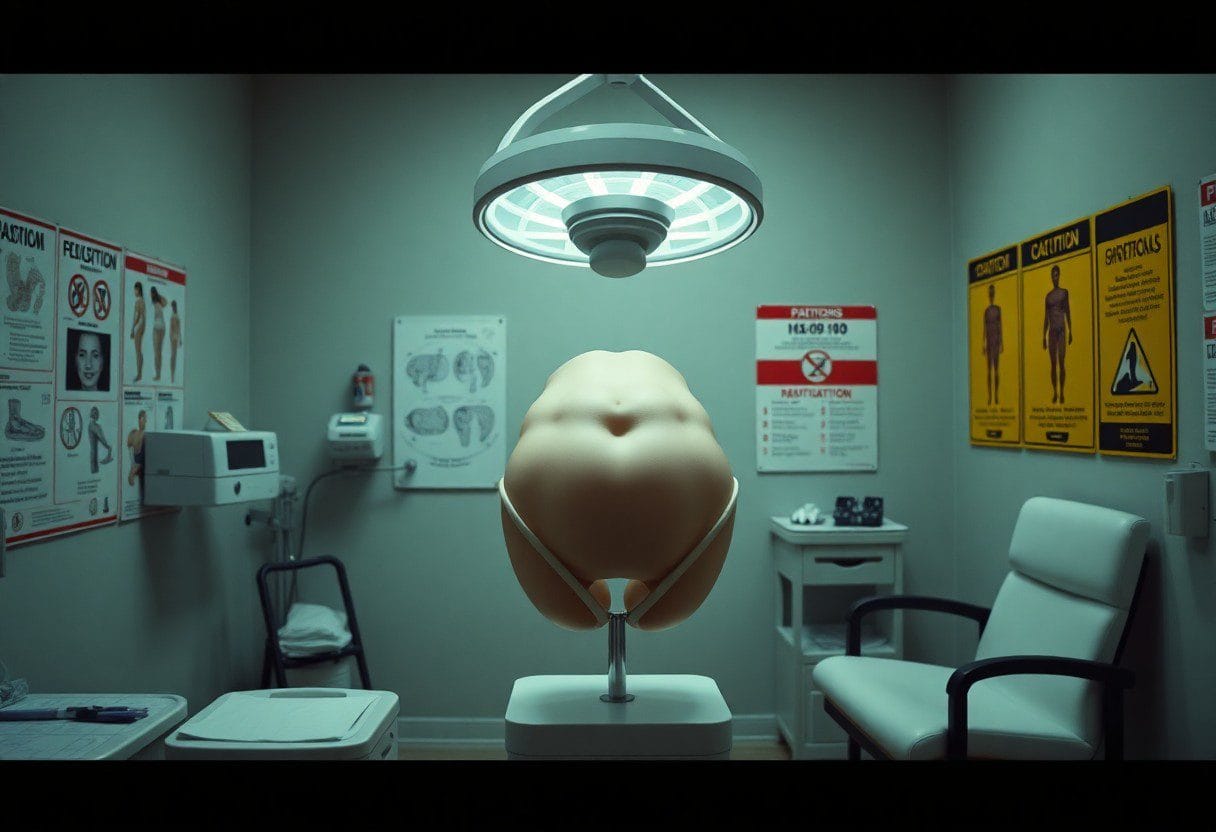Over the past few years, the Brazilian Butt Lift (BBL) has gained immense popularity for its ability to enhance your curves. While many individuals seek this cosmetic procedure for aesthetic reasons, it’s crucial to understand the potential risks and complications that can arise. This informative blog post will provide you with valuable insights into what you need to consider before undergoing a Brazilian Butt Lift, ensuring you’re well-prepared to make an informed decision about your body and health.

The Unseen Dangers: Health Risks of a Brazilian Butt Lift
Pursuing a Brazilian Butt Lift can come with several hidden health risks that you need to be aware of before making a decision. While the procedure can enhance your figure significantly, it can also lead to serious complications that could impact your overall health. Understanding these risks, especially the critical concerns related to fat transfers, is vital for making an informed choice about your body.
Fat Embolism Syndrome: A Critical Concern
Fat embolism syndrome (FES) is one of the most alarming risks associated with a Brazilian Butt Lift. During the procedure, fat is injected into specific areas of the buttocks to achieve the desired shape. If any of this fat enters your bloodstream, it can travel to your lungs, brain, or other organs, leading to life-threatening conditions. Symptoms of FES can manifest suddenly and include shortness of breath, confusion, and a rash. Studies indicate that the risk of FES, although rare, remains a grave concern in cosmetic surgeries like this.
Infection and Post-Operative Complications
Infection is a common risk following any surgery, and a Brazilian Butt Lift is no exception. Post-operative complications can vary from mild infections requiring antibiotics to more severe issues that necessitate further surgical intervention. Recognizing signs of infection early on, such as fever, increased pain, or swelling, can make all the difference in your recovery, ensuring that you address concerns before they escalate.
Infection after a Brazilian Butt Lift can arise from bacteria entering the surgical site during or after the procedure. In fact, a significant percentage of patients experience complications ranging from minor infections to more serious conditions, requiring hospitalization. Even when surgical techniques are meticulously applied, factors like individual health, the surgical environment, and post-operative care play vital roles in determining susceptibility. Following your surgeon’s aftercare instructions, maintaining hygiene, and attending scheduled follow-up appointments significantly mitigate these risks, promoting a smoother recovery process.
Navigating Surgical Pitfalls: Complication Awareness
A Brazilian Butt Lift, while offering transformative aesthetic results, can also present significant challenges during and after the procedure. Being aware of potential complications is key to ensuring a safer surgical experience. From reactions to anesthesia to the risk of surgical errors, understanding these pitfalls will enable you to take proactive measures in your pre-surgery planning and decision-making.
Anesthesia Reactions: Risks You Should Consider
Anesthesia is a critical component of any surgical procedure, including a Brazilian Butt Lift. You may experience adverse reactions ranging from mild nausea to severe respiratory issues. The likelihood of complications increases if you have pre-existing health conditions or a history of previous reactions to anesthetics, making it necessary to discuss your medical history thoroughly with your anesthesiologist.
Surgical Errors: The Rare but Real Threat
Surgical errors can occur in any procedure, including a Brazilian Butt Lift, though they are uncommon. These mistakes may include improper fat injection techniques, leading to uneven results or even fat embolisms. Such errors can jeopardize not only your aesthetic outcomes but also your overall health, necessitating further corrective procedures.
Research indicates that while surgical errors are rare, they highlight the importance of choosing a board-certified plastic surgeon with specific expertise in the Brazilian Butt Lift. Poor technique or inexperience may result in serious complications like infection or skin necrosis. Engaging in comprehensive consultations and reviewing before-and-after photos from previous patients can help minimize these risks and guide you toward the right surgical team for your desired results.
The Long-Term Implications: What to Expect After Surgery
Post-surgery, many individuals experience significant changes in their body shape and proportions that can evolve over time. Your body responds to the fat transfer in ways that might not be immediately visible. Healing takes time, and it’s crucial to be aware that your results may continue to change as swelling subsides and your body stabilizes in the months following the procedure.
Shifting Body Contours: Changes Over Time
As time progresses, expect to see your body contours shift. Factors such as aging, weight fluctuations, and lingering fat absorption can affect both the transplanted fat and your overall figure. It’s common for results to soften over time, but maintaining a stable weight can help preserve your newly enhanced shape.
Chronic Pain and Discomfort: An Unexpected Price
Chronic pain may occur in some individuals, manifesting as persistent aches or discomfort around the surgical sites. While not universal, it can represent a significant drawback that some people do not anticipate. In severe cases, the discomfort can hinder normal activities, impacting your quality of life.
This chronic pain can arise from nerve damage or inflammation in the treated areas. Some patients report that their discomfort limits movement or causes difficulty in sitting, which can lead to complications in daily life. If you experience prolonged pain post-surgery, addressing it with your healthcare provider is imperative. Effective pain management and rehabilitation might be necessary to regain normalcy in your activities and overall well-being.

Preparing for Surgery: A Proactive Approach to Minimize Risks
Successfully minimizing risks associated with a Brazilian butt lift begins long before you step into the operating room. Diligently preparing for surgery can make a significant difference in your recovery and overall results. Consulting closely with your surgeon and following their pre-operative instructions sets the groundwork for a safer procedure. This may involve lifestyle adjustments, such as avoiding certain medications, refraining from smoking, and following a nutritious eating plan that supports your body’s healing capability.
Vetting Your Surgeon: The Importance of Experience
Finding a board-certified surgeon with a wealth of experience in Brazilian butt lifts significantly impacts your safety and satisfaction. Look for credentials that demonstrate expertise, such as membership in relevant professional organizations and positive patient testimonials. An experienced surgeon will not only help you achieve desired results but also anticipate potential complications and handle them deftly should they arise.
Pre-Surgical Health Optimization: Steps to Fortify Your Body
Your physical health plays a vital role in how well you’ll recover from surgery. Focusing on nutrition, exercise, and managing any pre-existing medical conditions can bolster your body’s resilience. For instance, incorporating a balanced diet rich in protein, vitamins, and minerals can enhance healing properties. Aim to engage in regular cardiovascular and strength-training activities to improve blood circulation and promote overall physical health, paving the way for a smoother surgical experience and recovery.
Emphasizing health optimization ahead of your Brazilian butt lift involves some simple yet effective steps. Prioritize whole foods like fruits, vegetables, lean proteins, and whole grains while minimizing processed foods, which can lead to inflammation. Staying well-hydrated is equally important, as hydration supports skin elasticity and healing. Additionally, consider consulting a nutritionist or personal trainer to help tailor a plan that aligns with both your surgery goals and overall wellness, ensuring your body is in peak condition during your surgical journey.
Cultural Influences and Body Image: The Role of Social Media
Social media profoundly shapes perceptions of beauty, often highlighting exaggerated body types that can set unrealistic standards. Platforms like Instagram and TikTok have popularized trends surrounding curvier figures, resulting in the rise of procedures like Brazilian butt lifts. The constant exposure to heavily curated images can lead you to question your own body image, with influencers frequently opting for cosmetic enhancements to fit these ideals.
The Pressure to Conform: Societal Expectations Explored
Increasingly, societal expectations dictate your body image, aligning with a narrow definition of beauty that emphasizes certain physical traits. This pressure can make you feel inadequate if you don’t conform to these norms. Many individuals feel compelled to pursue surgical procedures, such as Brazilian butt lifts, in hopes of achieving an idealized silhouette portrayed in popular culture.
Body Positivity: Rethinking Aesthetic Goals
The body positivity movement encourages you to embrace and celebrate your unique body, challenging traditional aesthetic goals. Instead of striving for an idealized body shape, you’re prompted to reflect on your own values and what makes you feel confident. This shift towards acceptance can provide a healthier perspective, moving away from the need for surgery and instead focusing on well-being and self-love.
Rethinking aesthetic goals through a body positivity lens invites you to reassess not only personal habits but also societal pressures. You might find that true beauty lies in diversity, which can lead to greater acceptance of various body types. Emphasizing health over appearance helps cultivate a mindset where you appreciate your individuality rather than striving for an unattainable standard. By participating in this movement, you can inspire others to challenge societal norms, fostering a culture of inclusivity and self-acceptance.
Summing up
Drawing together the potential risks and complications of a Brazilian Butt Lift, it is vital for you to be well-informed prior to undergoing the procedure. Risks such as infection, blood clots, and reaction to anesthesia can occur, as well as complications like asymmetry or fat necrosis. In some cases, serious conditions such as fat embolism may arise, posing further health threats. Ensuring you choose a qualified surgeon and adhere to pre- and post-operative guidelines can significantly reduce these risks, enhancing your overall safety and satisfaction with the results.
Q: What are the primary risks associated with a Brazilian Butt Lift?
A: The Brazilian Butt Lift (BBL) involves liposuction and fat grafting, which carry inherent risks. Some primary risks include infection, bleeding, and anesthesia complications. Liposuction can also lead to irregular contours if the fat is not evenly distributed. In severe cases, there is a risk of fat embolism, where fat enters the bloodstream and travels to the lungs, potentially causing serious health issues. It is vital to choose a board-certified surgeon with experience in this procedure to minimize these risks.
Q: What complications might arise from the fat grafting process in a Brazilian Butt Lift?
A: During the fat grafting process, a portion of the transferred fat may not survive, leading to unevenness or asymmetry in the results. Furthermore, poorly performed grafting can result in the formation of lumps or nodules under the skin. Additionally, there is a possibility of calcification in the area where the fat has been injected, which may require further intervention to correct. Patients should discuss these potential issues with their surgeon to understand the likelihood and management of complications.
Q: How can I reduce the risks and complications associated with a Brazilian Butt Lift?
A: To reduce risks and complications, it is vital to select a qualified and experienced plastic surgeon who specializes in BBL procedures. Discussing your health history in detail, following pre-operative and post-operative instructions, and attending all follow-up appointments can also help in mitigating adverse effects. Furthermore, maintaining a stable weight, avoiding smoking, and adhering to a healthy lifestyle will contribute positively to the recovery process and overall results.